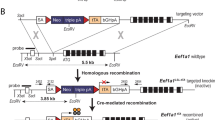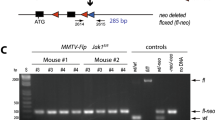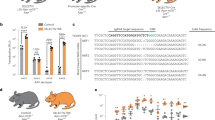Abstract
We have developed and tested successfully a general method based on Cre-mediated recombination that can be used for ubiquitous or tissue-specific expression of protein products, including tumor-inducing oncoproteins. Depending on the specificity of a chosen promoter driving cre expression, tumors develop by design in bitransgenic mouse progeny derived by crossing Cre-producing mice with partners carrying a dormant oncogenic transgene (targeted into the 3′ noncoding region of the cytoplasmic β-actin locus) that becomes functional after excision of a ‘floxed’ DNA segment. To provide proof-of-principle, we have used as models transgenes encoding the polyomavirus middle T antigen (PVMT) and the T antigens of the SV40 early region (SVER). Cre-dependent activation of widespread SVER expression resulted in hyperplasias or invasive tumors affecting particular visceral smooth muscles, whereas Cre-dependent, mammary gland-specific expression of PVMT-induced adenocarcinomas, according to plan. Unexpectedly, we also encountered spontaneous (Cre-independent) oncogene expression occurring as a rare event, which simulates the initiation of sporadic tumors and leads to PVMT-induced hemangiomas and mammary carcinomas or SVER-induced disseminated sarcomas, thus, revealing particular tissue susceptibilities to the actions of these oncoproteins.
This is a preview of subscription content, access via your institution
Access options
Subscribe to this journal
Receive 50 print issues and online access
$259.00 per year
only $5.18 per issue
Buy this article
- Purchase on Springer Link
- Instant access to full article PDF
Prices may be subject to local taxes which are calculated during checkout



Similar content being viewed by others
References
Barrett JC and Wiseman RW . (1992). Prog. Clin. Biol. Res., 376, 1–30.
Bautch VL, Toda S, Hassell JA and Hanahan D . (1987). Cell, 51, 529–537.
Berns A . (2001). Nature, 410, 1043–1044.
Bronson SK, Plaehn EG, Kluckman KD, Hagaman JR, Maeda N and Smithies O . (1996). Proc. Natl. Acad. Sci. USA, 93, 9067–9072.
Choi YW, Lee IC and Ross SR . (1988). Mol. Cell. Biol., 8, 3382–3390.
Darby I, Skalli O and Gabbiani G . (1990). Lab. Invest., 63, 21–29.
Dietrich P, Dragatsis I, Xuan S, Zeitlin S and Efstratiadis A . (2000). Mamm. Genome, 11, 196–205.
Dorer DR . (1997). Transgenic Res., 6, 3–10.
Efstratiadis A, Posakony JW, Maniatis T, Lawn RM, O'Connell C, Spritz RA, DeRiel JK, Forget BG, Weissman SM, Slightom JL, Blechl AE, Smithies O, Baralle FE, Shoulders CC and Proudfoot NJ . (1980). Cell, 21, 653–668.
Elder PK, French CL, Subramaniam M, Schmidt LJ and Getz MJ . (1988). Mol. Cell. Biol., 8, 480–485.
Eyden B . (2001). Ultrastruct. Pathol., 25, 39–50.
Floros J, Jonak G, Galanti N and Baserga R . (1981). Exp. Cell Res., 132, 215–223.
Guy CT, Cardiff RD and Muller WJ . (1992). Mol. Cell. Biol., 12, 954–961.
Hollies CR, Monckton DG and Jeffreys AJ . (2001). Eur. J. Hum. Genet., 9, 143–146.
Jackson EL, Willis N, Mercer K, Bronson RT, Crowley D, Montoya R, Jacks T and Tuveson DA . (2001). Genes Dev., 15, 3243–3248.
Johnson L, Mercer K, Greenbaum D, Bronson RT, Crowley D, Tuveson DA and Jacks T . (2001). Nature, 410, 1111–1116.
Kim DG, Kang HM, Jang SK and Shin HS . (1992). Mol. Cell. Biol., 12, 3636–3643.
Kislauskis EH, Zhu X and Singer RH . (1994). J. Cell. Biol., 127, 441–451.
Lakso M, Sauer B, Mosinger Jr B, Lee EJ, Manning RW, Yu SH, Mulder KL and Westphal H . (1992). Proc. Natl. Acad. Sci. USA, 89, 6232–6236.
Lander ES et al. (2001). Nature, 409, 860–921.
Ludwig T, Fisher P, Murty V and Efstratiadis A . (2001). Oncogene, 20, 3937–3948.
Mao X, Fujiwara Y and Orkin SH . (1999). Proc. Natl. Acad. Sci. USA, 96, 5037–5042.
Mombaerts P, Wang F, Dulac C, Chao SK, Nemes A, Mendelsohn M, Edmondson J and Axel R . (1996). Cell, 87, 675–686.
Palmiter RD and Brinster RL . (1986). Annu. Rev. Genet., 20, 465–499.
Politi K, Szabolcs M, Fisher P, Kljuic A, Ludwig T and Efstratiadis A . (2004). Am. J. Pathol., 164, in press.
Ratineau C, Ronco A and Leiter AB . (2000). Gastroenterology, 119, 1305–1311.
Seperack PK, Strobel MC, Corrow DJ, Jenkins NA and Copeland NG . (1988). Proc. Natl. Acad. Sci. USA, 85, 189–192.
Srinivas S, Watanabe T, Lin CS, William CM, Tanabe Y, Jessell TM and Costantini F . (2001). BMC Dev. Biol., 1, 4.
Thomas BJ and Rothstein R . (1989). Cell, 56, 619–630.
Treisman R, Novak U, Favaloro J and Kamen R . (1981). Nature, 292, 595–600.
Wallace H, Ansell R, Clark J and McWhir J . (2000). Nucleic Acids Res., 28, 1455–1464.
Webster MA, Hutchinson JN, Rauh MJ, Muthuswamy SK, Anton M, Tortorice CG, Cardiff RD, Graham FL, Hassell JA and Muller WJ . (1998). Mol. Cell. Biol., 18, 2344–2359.
Williams RL, Courtneidge SA and Wagner EF . (1988). Cell, 52, 121–131.
Zerrahn J, Knippschild U, Winkler T and Deppert W . (1993). EMBO J., 12, 4739–4746.
Acknowledgements
We thank Drs Tom Benjamin, Jean Dahl, Stephen Dilworth and Jim Manley and the laboratory of Dr Michael Getz for kindly providing reagents, Joe Terwilliger, Shouhong Xuan, Zhe Li, and Apostolos Klinakis for discussions, and Elson Ospina, Qiong Li and Lejuan Chatman for expert technical assistance. This work was supported by NCI grants P01 CA75553 (Project 3) and P01 CA97403 (Project 2) to A Efstratiadis. Additional support was provided by grant DAMD17-00-1-0079 from the Department of the Army and by a grant to the Herbert Irving Comprehensive Cancer Center of the Columbia Presbyterian Medical Center from the Avon Products Foundation Breast Cancer Research and Care Program. K Politi was supported by a predoctoral fellowship provided by the Cancer Biology Training Grant T32 CA09503.
Author information
Authors and Affiliations
Corresponding author
Rights and permissions
About this article
Cite this article
Politi, K., Kljuic, A., Szabolcs, M. et al. ‘Designer’ tumors in mice. Oncogene 23, 1558–1565 (2004). https://doi.org/10.1038/sj.onc.1207275
Received:
Revised:
Accepted:
Published:
Issue Date:
DOI: https://doi.org/10.1038/sj.onc.1207275
Keywords
This article is cited by
-
Spontaneous expression of the CIC::DUX4 fusion oncoprotein from a conditional allele potently drives sarcoma formation in genetically engineered mice
Oncogene (2024)
-
MYC in pancreatic cancer: novel mechanistic insights and their translation into therapeutic strategies
Oncogene (2016)
-
Wnt Signaling, Stem Cells, and the Cellular Origin of Breast Cancer
Stem Cell Reviews (2007)
-
Functional consequences of IGFBP excess?lessons from transgenic mice
Pediatric Nephrology (2005)



